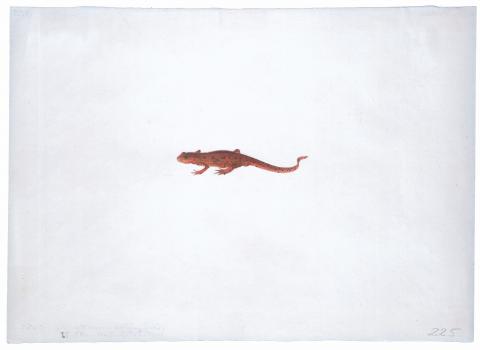August 20, 1832
20 August: In the morning, bright sky and sunshine. At six thirty, temperature of 14 1/2°R [64.6°F, 18.1°C]. At seven thirty, excursion to the Lecha Mountain. When we arrived at the mountain and forest, we took an old path and, at a certain height, reached a wild region where the forest had been cut down. Here much rocky debris lay about. The brush consisted mostly of sprouts of Quercus coccinea, tinctoria, alba, sassafras, Juglans alba and nigra, etc., but the tall, beautiful oak with coarse bark, which here is called chestnut oak (Quercus prinus), was the tree that flourished best; its leaves resemble those of the chestnut (Castanea vesca and americana) but are more rounded and not as long.
My companion (Mr. Wöhler) missed a hare (Lepus americanus), which jumped up in front of us. We went on through dense, tall forest. There was rather much undergrowth here, particularly of chestnuts and chestnut oaks.M13In these forests the strange shrub Comptonia asplenifolia grows abundantly but blooms early, before its foliage emerges. The chestnut tree is very popular, not for burning or manufacturing, because it is light, but rather for making enclosures (fences) around fields, where it is said to last often up to sixty years.
We bagged a magnificent scarlet tanager (Tanagra rubra) in its transitional plumage, beautifully spotted in greenish yellow and red. Then, at the foot of an old trunk on a rotting Agaricus, I found two nice orange-colored salamanders with red and black dots (Salamandra aurantia), which had probably been feeding on this soft rotting mass. They found quarters in my vasculum.
Now we approached the valley again, shot a Picus pubescens and several small birds, including Wilson’s red-eyed flycatcher, as well as Muscicapa ruticilla, among others, and then entered the edge of the field. Here, in a small marsh, we caught sight of a beautiful painted turtle (Emys picta), which, however, immediately submerged, and then we left the beautiful tall forest. We had felt very comfortable in the cool shade of the tall oak and walnut trees, whereas it was very hot in the field. The summit of that Lecha Mountain provides an excellent view. The entire valley of the Lecha, including Bethlehem, an intermittently wooded region, lay spread out before us. To the right, on the horizon, the Delaware Gap, where this river breaks through the mountains, etc. We returned along the bank of the Lecha, where we shot several additional birds, most of which, however, were very definitely too much in the molting stage. At home we again found many natural history specimens, including snakes, frogs, insects. The plants collected kept me occupied all afternoon, while Dreidoppel had very many animals to prepare.



